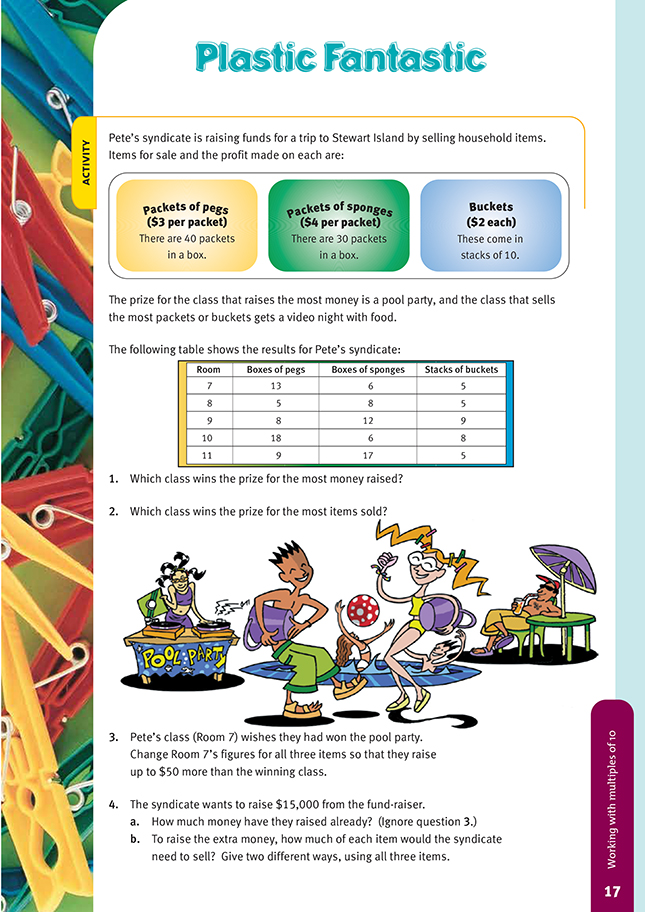This is a level 4 number link activity from the Figure It Out series. It relates to Stage 7 of the Number Framework.
A PDF of the student activity is included.
Click on the image to enlarge it. Click again to close. Download PDF (408 KB)
solve multiplication problems using multiples of ten
FIO, Link, Number, Book Five, Plastic Fantastic, page 17
This activity contains a series of problems that seem relatively simple on the surface but that have some challenges embedded in them. For example, to find solutions to questions 1 and 2, the students will have to calculate the income and total number of items sold by each of the five classes.
Another challenge is that the problems do not have simple one-step solutions. As in many problem-solving questions, the information needed for a calculation is not always immediately obvious. For example, to calculate the fund-raising effort of Room 7, the students will have to keep in mind that the selling price for the pegs is based on a packet, whereas the quantity sold is listed in boxes. The same is true for the sponges and buckets.
Questions 3 and 4 show that problems can often have more than one solution. The students may find it interesting to hear the solutions that others in the class have come up with and to consider whether those solutions are justified.
One extension to this activity, which illustrates how solutions to problems can vary depending on how aspects of the problem are defined, is as follows:
“The owners of a house want to pave the driveway at their new home. The driveway is 20 metres long and 5 metres wide. How many pavers are the owners likely to need, and what cost would they be looking at?”
Solutions will vary according to things such as:
• whether the owners wish to pave the whole width or perhaps just a 3 metre section down the middle (leaving a 1 metre strip either side in grass);
• the size, thickness, and design of the pavers;
• the cost of different pavers, and indeed the cost of the same pavers from different outlets. (They are likely to be cheaper at a manufacturer’s yard than at a retailer’s premises.)
The extension problem need not be actually solved. You could use it just to explore and discuss the issues involved.
Answers to Activity
1. Room 11, with $3,220
(The other results were: Room 7: $2,380; Room 8: $1,660; Room 9: $2,580;
Room 10: $3,040.)
2. Room 10, with 980 items
(The other results were: Room 7: 750; Room 8: 490; Room 9: 770; Room 11: 920.)
3. Answers will vary but must add up to more than $3,220 and less than $3,270.
For example: 161/2 boxes of pegs, 9 boxes of sponges, and 10 stacks of buckets, equalling $3,260
4. a. $12,880
b. Various solutions, adding up to at least $2,120.
For example: 71/2 boxes of pegs equalling $900, 8 boxes of sponges equalling $960, and 13 stacks of buckets equalling $260; or 8 boxes of pegs equalling $960, 8 boxes of sponges equalling $960, and 10 stacks of buckets equalling $200.
